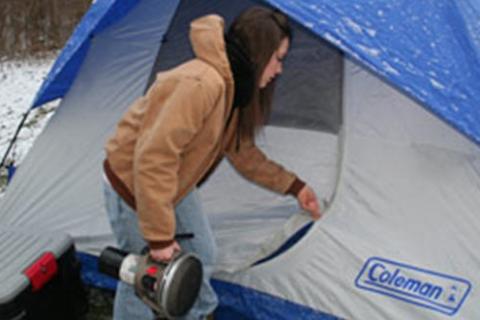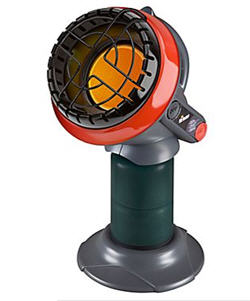
The leaves have completed their fall, exposing the tree skeleton; sure sign cold temps are on the horizon. A small percentage of avid tent campers are not intimidated by the chilling weather and keep on camping. Obviously, the same gear and tent camping set up used in July will not cut it during November through February. Following a few of the following tips, will keep you tenting well into the winter season.
Most campgrounds are closed for the season, as most cold-camping destinations are in state and national parks, or on private land. A key to planning a cold camping trip is keeping time in mind. Everything a camper does will take longer than normal; traveling, setting up, cooking and other camp chores. So schedule extra time to get it all done.
 |
| Mr. Heater® Little Buddy will provide a bit of warmth while tent camping in cold weather |
Proper clothing is essential. Dressing for the night, choose clothing to assist sleeping gear to provide a restful sleep. As your mother preached to you as a kid, most heat will be lost through the head. A stocking cap will not only keep your head dry and warm during the daytime hours, but also while sleeping.
Most shower facilities are closed for the winter, so a really quick sponge bath may be the only option. Warmed water on a backpack stove or camp stove will provide a refreshing splash. Dressing in layers works well when the daytime temperatures rise much compared to the night temps. Boots, gloves, pants and upper body under garments are best if made with synthetic, sweat wicking abilities. Leave any cotton garments home, they lose insulating abilities when they become wet. Be sure to pack plenty of socks — cold feet can make the entire body feel miserable.
Adjusting for a Winter Camp
A few adjustments of camp setup will make for a comfortable winter camp. Choosing a campsite with natural windbreaks, but open to the morning and afternoon sun, and near a supply of firewood, is the ideal winter camp location.
Before pitching a tent on snow-covered ground, clear the spot for the tent. If the ground is frozen, replace stakes by tying anchor lines to a few pieces of firewood or chunks of deadfall. A nylon tarp is a winter camper’s best tool. If the wind picks up, stretch a tarp from tree to tree, providing a windbreak for the tent, campfire or cooking area.![]() Read: How to maximize space in a camping tent.
Read: How to maximize space in a camping tent.
Sleeping bags must have the highest rating for cold weather as possible or can be afforded. Use a sleeping pad made of the thickest and densest foam possible. For extra heat, bring along several disposable chemical heat packs. Most of these little bags will last for 12 hours or more. Regarding heaters used in tents, only heaters rated for indoor use and feature an oxygen depletion detector should be used.![]() Read: How to choose the best sleeping bag.
Read: How to choose the best sleeping bag.
Additional gear such as cameras, flashlights and a radio require back up power supplies as the cold temperatures drain the batteries rapidly. A radio can keep the camper informed of approaching, inclement weather. As always, be sure a first-aid kit is available.
- 7720 views

